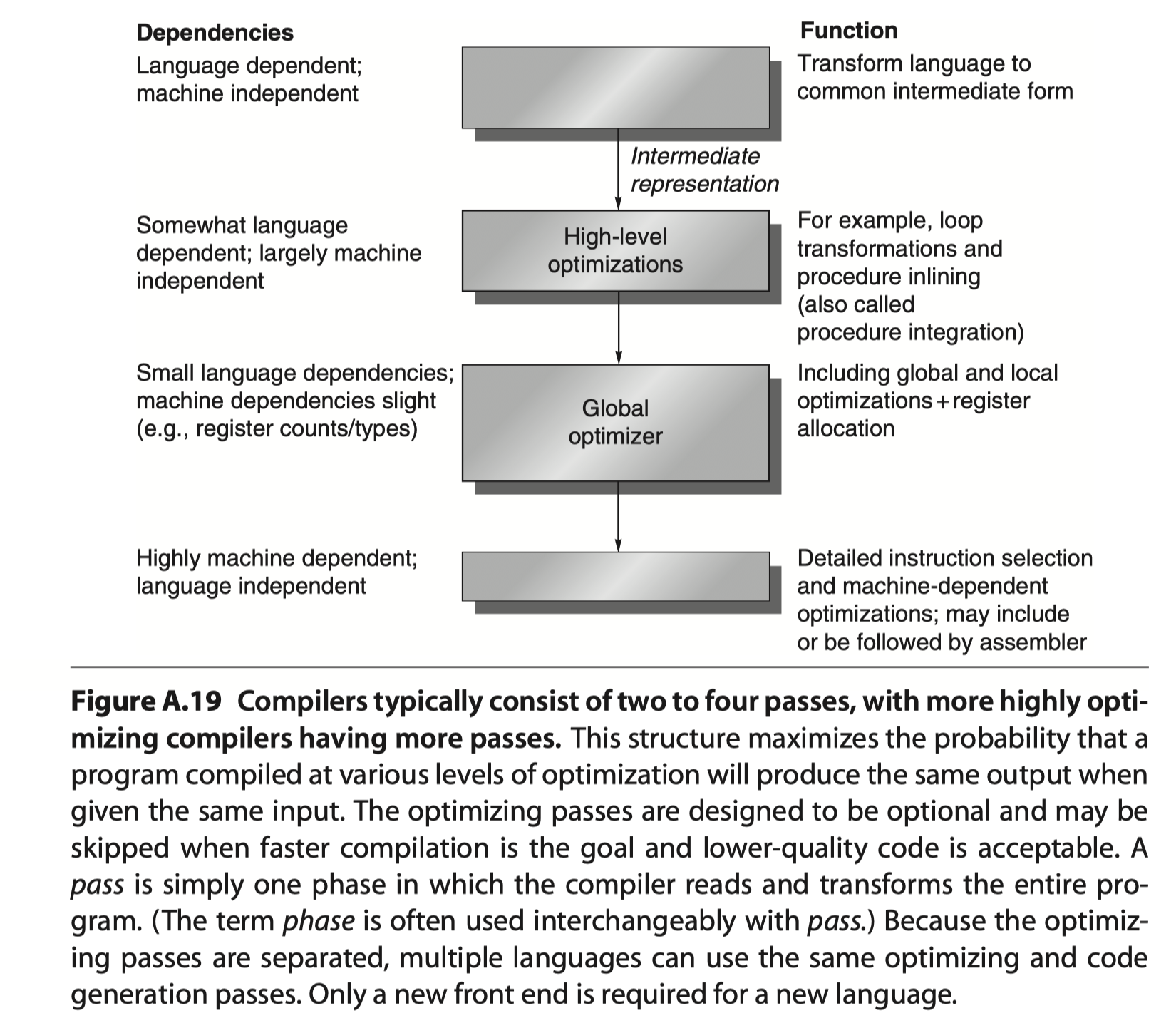Instruction Set Principles
- Appendix A in Computer Architecture A Quantitative Approach (6th) by Hennessy and Patterson (2017)
Introduction
- Instruction set architecture:
- The portion of the computer visible to the programmer or compiler writer
Classifying Instruction Set Architectures
- Alternatives inside a processors
- Stack vs Accumulator vs Set of registers
- One of operands
- Stack architecture: Implicitly on top of stack
- Accumulator architecture: Implicitly the accumulator
- General-purpose register (GPR) architecture: Only explicit operands (reg or mem)
- Register Computers
- Register-memory architecture
- Load-store architecture
- Memory-memory architecture
- More registers for special case usage
- Extended accumulator
- Special purpose register computer
- Why GPR? Registers are …
- Efficient!
- Good for compliers to use than other types of storage
- Able to hold variables
- Q. How many regs?
- Compliers would prefer that all regs be equivalent and unreserved
- So, the answer depends on the effective of the complier
- Two major instruction set characteristics of GPR architecture
- ALU instructions has two or three operands?
- How many operands may be memory addresses in ALU instructions?
- Zero: Load-store architecture
- One: Register-memory architecture
- Two/Three: Memory-memory architecture
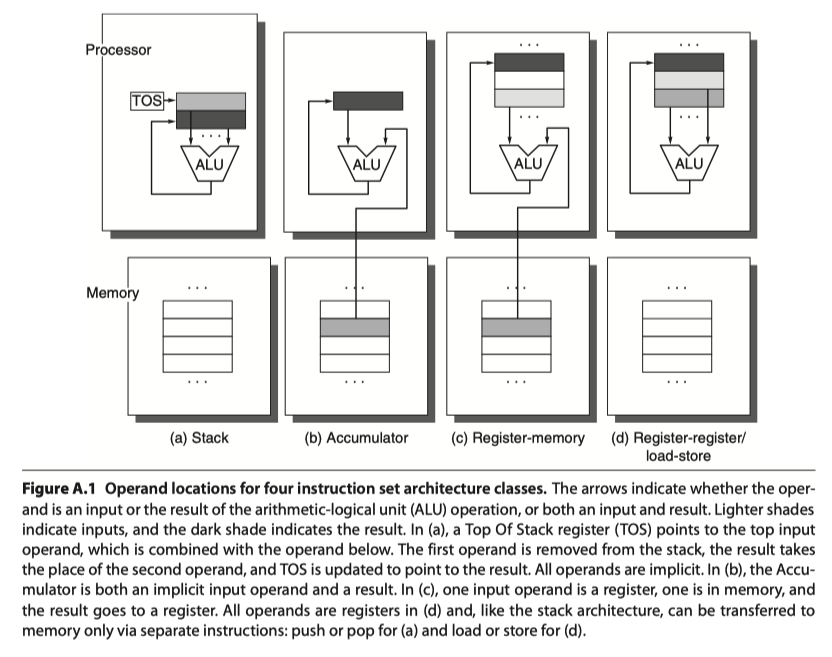
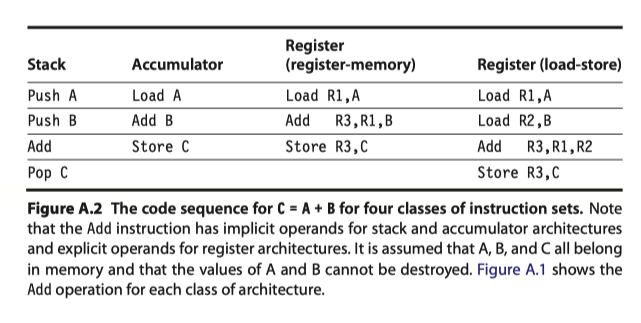
Memory Addressing
- How memory addresses are interpreted and how they are specified?
Interpreting memory addresses
- Conventions for ordering the bytes within a larger object
- Little Endian byte order: Put the 0th byte at the least significant position (to the left)
- Big Endian byte order: Put the 0th byte at the most significant position (to the right)
- String case?
- Big Endian: BACKWARD
- Litter Endian: DRAWKCAB
- Object address alignment
- Address A with size S: A%S=0 $\rightarrow$ Aligned
- If misaligned, may need two memory accesses since memories are typically aligned on a multiple of word or double-word boundary
Addressing modes
- How architects specify the address of an object they will access?
- Advantages
- Significantly reduces instruction counts
- Disadvantages
- Add to the complexity of building a computer with increased average cycle-per-instruction (CPI)
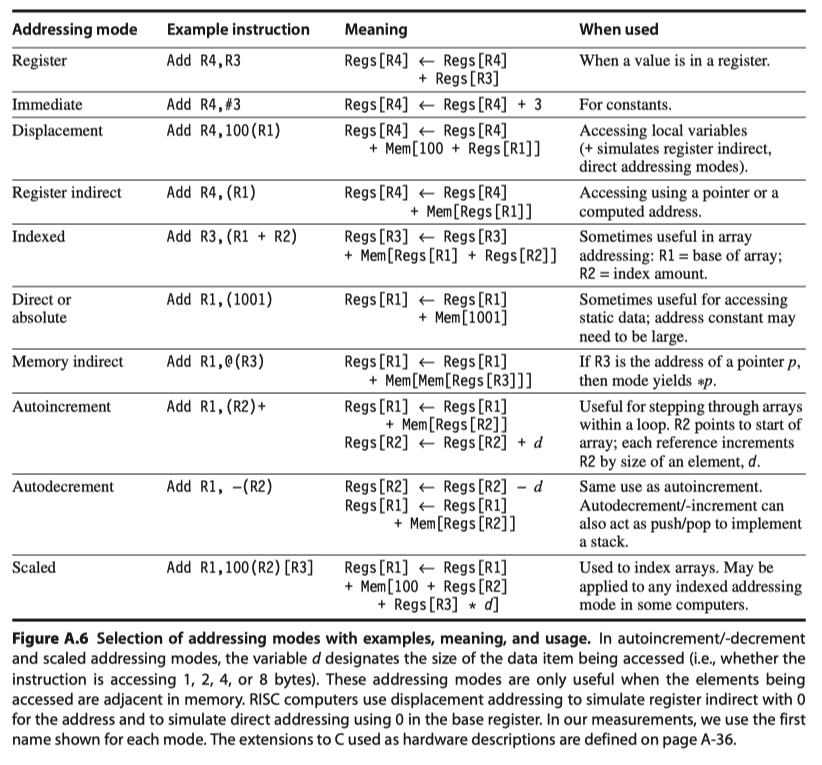
- Add to the complexity of building a computer with increased average cycle-per-instruction (CPI)
Displacement Addressing Mode
- eg. Add R4, 100(R1)
- Major questions? : proper range of displacements?
- Possible displacement range vs Instruction length
- In practice, same with the immediate size
Immediate or Literal Addressing Mode
- Used in arithmetic operations, comparison, and moves
- ~ 1/4 have an immediate operand
- Immediate instruction set measurement? :
- Support all operations? or just subset?
- proper range of values for immediates?
Summary: Memory Addressing
- Support at least the following addressing modes
- Displacement, immediate, register-indirect (77%-99%)
- The size of the address for displacement mode: at least 12-16 bits (75%-99%)
- The size of the immediate field: at least 8-16 bits
Type and Size of Operands
- Character 8b (Unicode 16b), half word 16b, word 32b, single-precision float 32b, double-precision float 64b …
- Should 64b access path be supported?
- How to designate the type of an operand?
- Encoding in the opcode: Most often
- A tag annotated to the data and hardware-based interpretation: Out-of-date
Operations in the instruction set
- Categories of instructions include in most ISAs
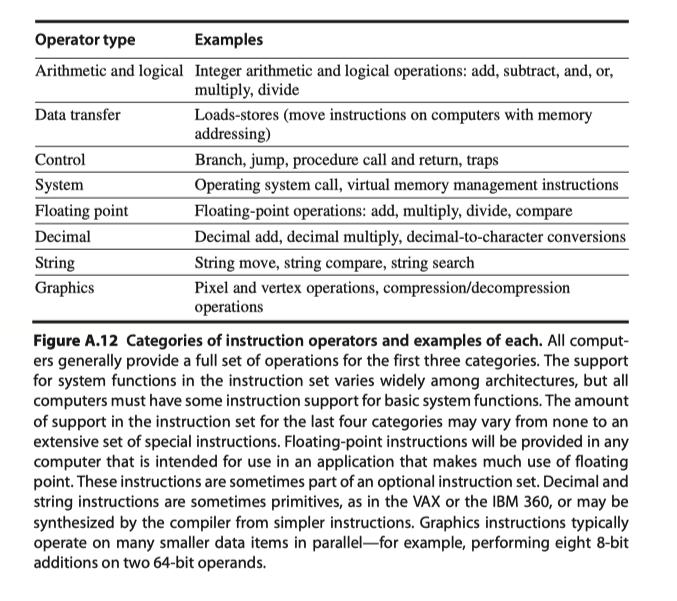
- 10 Most frequently used instructions
- So, make these operations faster!

Instructions for Control Flow
- Change in control
- Unconditional: Jump
- Conditional: Branch
- Four different types of control flow change:
- Conditional branches
- Jumps
- Procedure calls
- Procedure returns
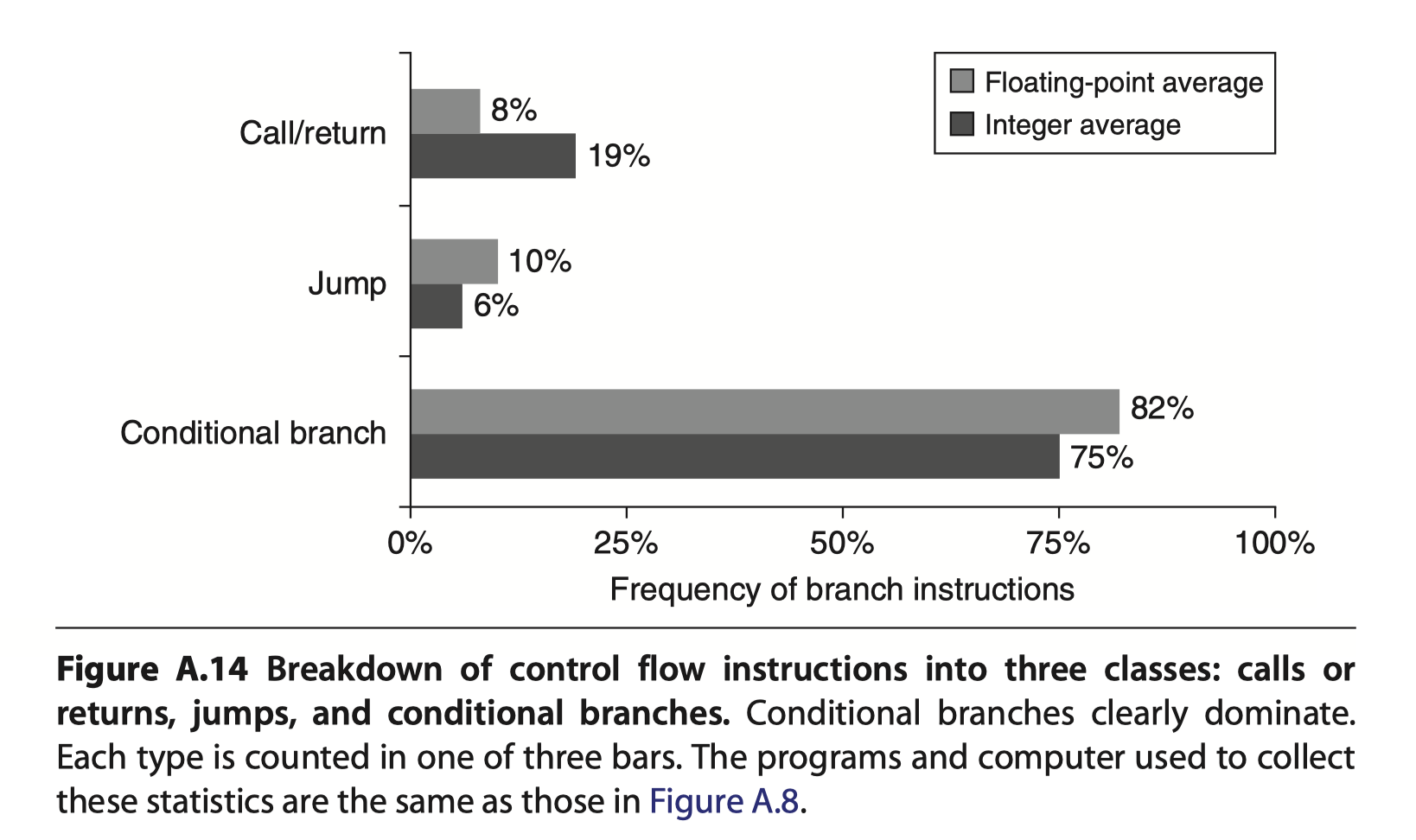
Address Modes for Control Flow Instructions
- Always specify the destination address
- PC-relative control flow instructions:
- Program counter (PC) + Displacement
- Fewer bit displacement if the destination is not too far from current instruction
- Position independence
- Efficient when the program is linked / linked dynamically during execution
- Return/indirect jumps
- Need other than PC-relative addressing if the target is not know at compile time
- When to use Register Indirect Jumps (= Target address is not know at compile time)
- Case or switch statements (selects among several alternatives)
- Virtual functions or methods in OOP C++/Java (eg. method override)
- High-order functions or function pointers in C/C++ (function to be passed as arguments)
- Dynamically shared libraries (a library to be loaded/linked at runtime only)
- Next Question: How far branch targets are from branches?

Conditional Branch Options
- Three primary techniques to evaluate branch conditions
- Condition code
- Condition register
- Compare and branch
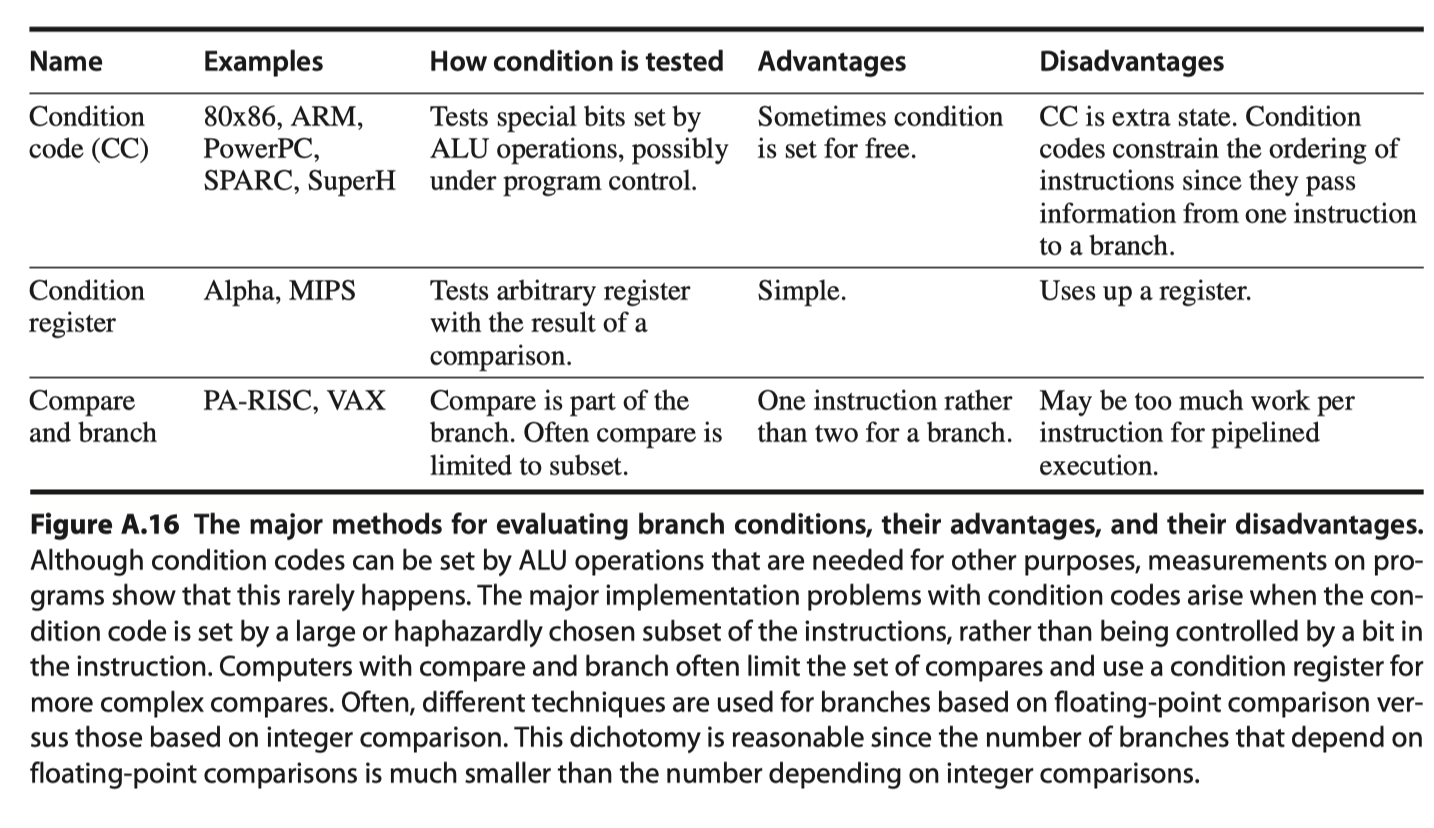
Procedure Invocation Options
- Return address must be saved somewhere
- Special link register or a GPR
- Two basic conventions to save registers
- Caller saving
- Callee saving
- Caller vs Callee saved registers?
- Example: RISC-V Bytes: Caller and Callee Saved Registers
Summary: Instructions for Control Flow
- Most frequently executed instructions
- New ISA needs to have
- Branch/Jump to hundreds of instruction distances $\rightarrow$ PC-relative branch displacement of at least 8 bits
- Register indirect, PC-relative addressing to support returns and others
- So New ISA should be like ….
- a load-store architecture
- with displacement, immediate, and register indirect addressing modes
- data: 8-, 16-, 32-, and 64-bit integers and 32- and 64-bit floating-point data
- Instructions for
- simple operations,
- PC-relative conditional branches,
- jump and link instructions
- for procedure call
- register indirect jumps
- for procedure return (plus a few other uses).
- a load-store architecture
Encoding an Instruction Set
- How to decode the binary representation of instruction?
- Specified with opcode
- The important decision: How to encode the addressing modes with the operations?
- 1 to 10 addressing modes
- 1 to 5 operands
- $\rightarrow$ Impact on the size of instructions
- Many more bits are consumed in encoding addressing modes and register fields than in specifying the opcode
- Competing forces when encoding the instruction set
- Desire to have many registers and addressing modes
- Impact of the size of registers and addressing mode fields
- Desire to regular instruction length for easy handling in pipelined implementation (at least, multiples of bytes)
- Three popular choices for encoding the instruction set
- Variable / Fixed / Hybrid
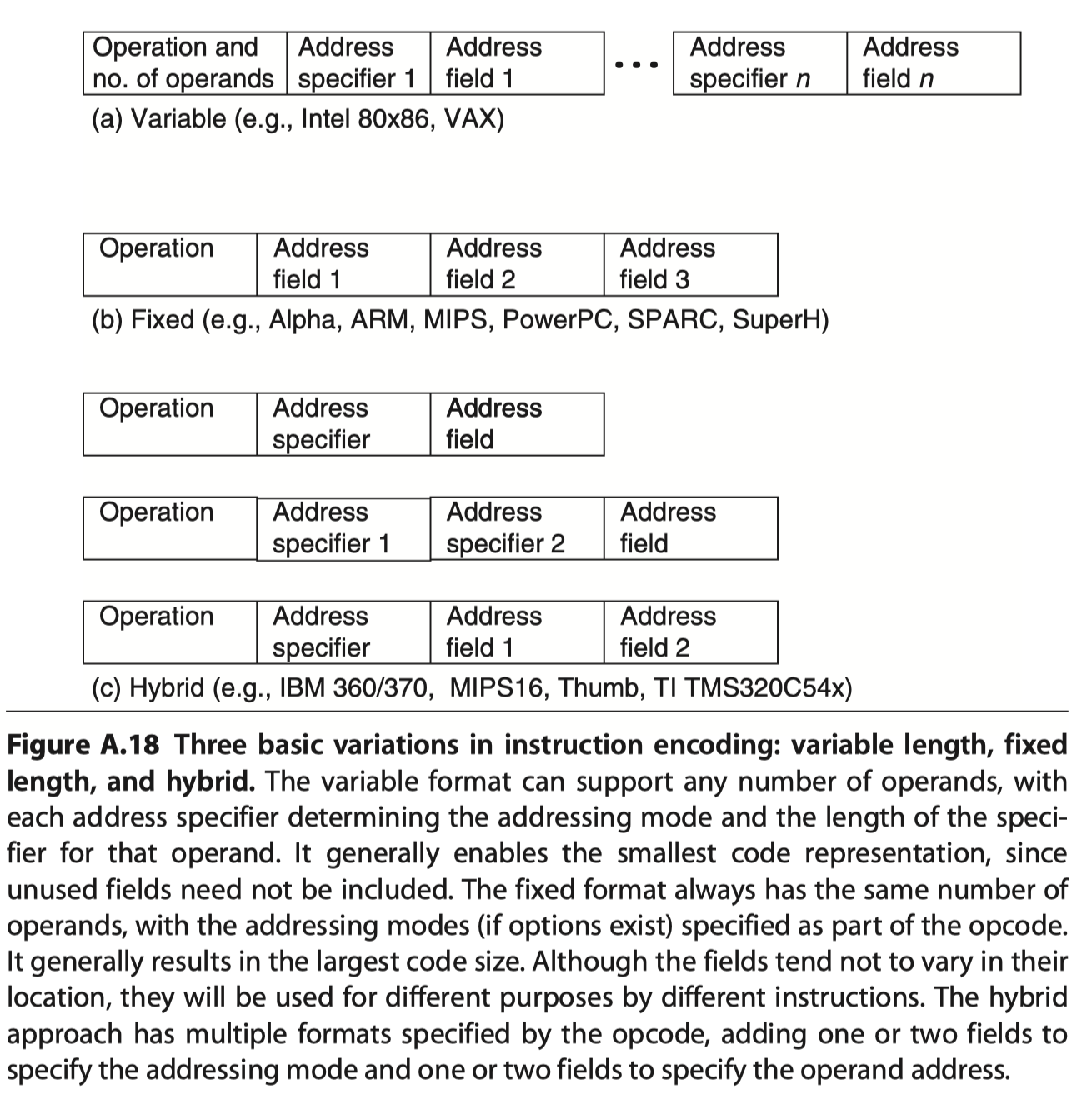
- Example of variable encoding in 80x86 (1~17 bytes)
- add EAX, 1000(EBX)
- 1 byte for opcode of 32 bit integer add operation with two operands
- 1 bytes for source/destination reg, addressing mode (displacement), and base reg.
- 4 bytes for the size of the address field ( = 1000 = $2^8$ > 1byte and < 4 byte)
- Thus, 6 bytes-instruction
Reduced Code Size in RISCs
- Standard = 32 bit instruction
- Hybrid
- Support both 16 (narrow instructions with less operations/address/immediates) and 32 bit
- Effectively, its instruction caches looks 25% larger
- Compression
- IBM simply hardware-base compress/decompress instructions with 32 bit (Run-length encoding)
- In memory: Compressed
- In instruction-cache: Decompressed
- Simple compiler and decoder
- To handle branches, a hash table in memory that maps between compressed and uncompressed addresses.
Summary: Encoding an Instruction Set
- More interested in performance: Variable encoding
- More interested in code size: Fixed encoding
Crosscutting Issues: The Role of Compilers
- Understanding compiler technology today is critical to designing and efficiently implementing an instruction set.
The Structure of Recent Compilers
- Goal?
- Correctness, speed of compiled code, fast compilation, debugging support, interoperability among language
- Optimization passes (phases)
- Phase ordering problem
- eg. global common subexpression elimination: store common results to temporary registers, and replace expressions with same results with the temporary registers. So, definitely need some registers to be reserved for the temporary results
- Optimization classes
- High-level optimizations
- Local optimizations (basic block)
- Global optimizations (across branches, optimizing loops)
- Register allocation
- Processor-dependent optimizations
Register Allocation
- Graph coloring
- Construct a graph representing the possible candidates for allocation to a register and then to use the graph to allocate registers
- Use a limited set of colors so that no two adjacent nodes in a dependency graph have the same color
- Achieve 100% register allocation
- NP-complete, heuristic algorithms
- Works best when there are at least 16 general-purpose registers available (more for floating-point)
Impact of Optimization on Performance
- Major types of optimizations and examples in each class

- Change in instruction count for the programs lucas and mcf from the SPEC2000 as compiler optimization levels vary
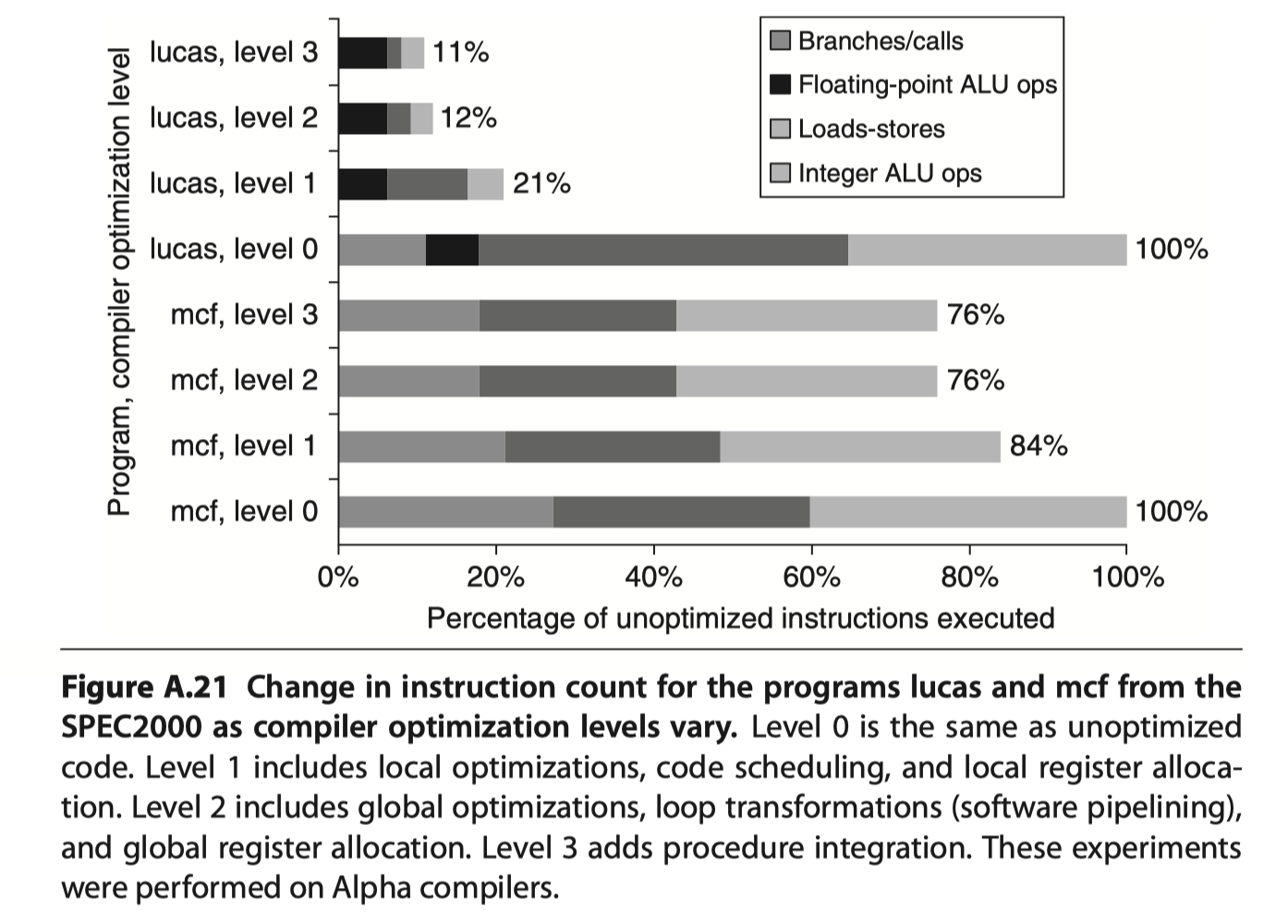
The Impact of Compiler Technology on the Architect’s Decisions
- How are variables allocated and addressed?
- How many registers are needed to allocate variables appropriately?
- Stack $\leftarrow$ Local variables
- Primarily scalars, addressed relative to the stack pointer
- Global data area $\leftarrow$ Statically declared objects such as global variables and constants
- Usually array or other aggregate data structures
- Heap $\leftarrow$ Dynamic objects
- Accessed by pointers
- Aliasing (reference a local variable with a pointer):
- Variables referred by pointers (a = *p) cannot be register allocated
- Difficult or impossible to decide what a pointer may refer to
How the Architect Can Help the Compiler Writer
- Provide regularity
- Make three primary components of instruction set to be orthogonal
- operations, data types, addressing modes
- Counter example: special-purpose registers
- Make three primary components of instruction set to be orthogonal
- Provide primitives, not solutions
- Simplify trade-offs among alternatives
- Provide instructions that bind the quantities known at compile time as constants
Compiler Support (or Lack Thereof) for Multimedia Instructions
- SIMD instruction designers ignored the previous subsection!
- Solutions, not primitives
- Short of registers
- Data types not matching existing program languages
- Require low-level graphics library and its own compiler technology
- Intel’s MMX
- with vectors of eight 8bit / four 16-bit / two 32-bit elements
- 64-bit = the sum of the sizes of the elements
- 128-bit = streaming SIMD extension (SSE)
- Vector computers
- Hiding latency of memory access
- Loading many elements at once
- Overlapping execution with data transfer
- Collect data scattered about memory
- eg. Strided addressing and gather/scatter addressing
- But, SIMD computers support only unit stride accesses
Putting It All Together: The RISC-V Architecture
- RISC-V emphasizes
- A simple load-store instruction set
- Design for pipelining efficiency including a fixed instruction set encoding
- Efficiency as a compiler target
- So, easy architecture to understand
RISC-V Instruction Set Organization
-
Three base instruction sets and the instruction set extensions
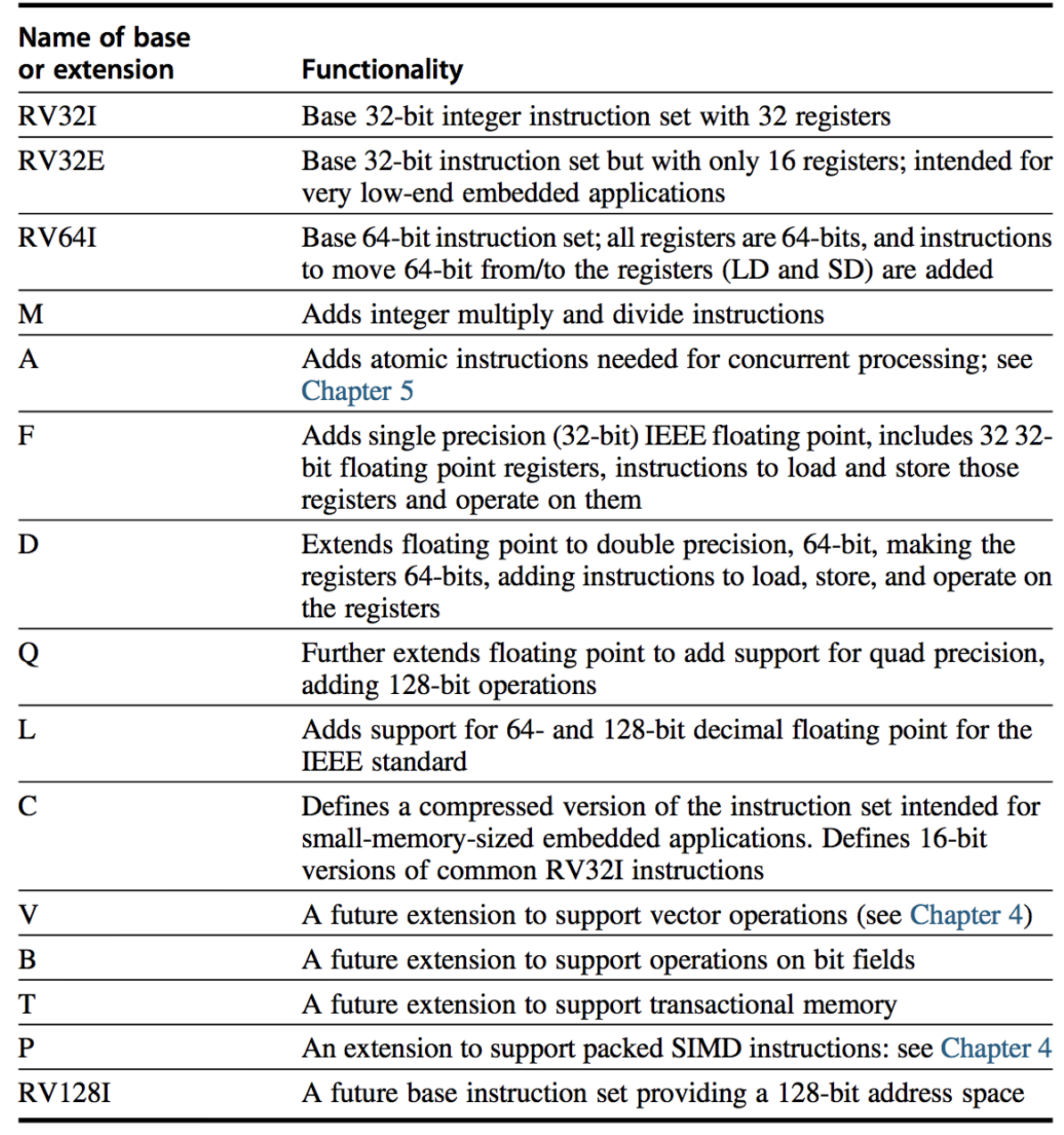
-
In this section, RV64IMAFD (aka RV64G) is illustrated
Registers for RISC-V
- 32 64-bit general-purpose registers (GPR, aka integer registers, x0-x31)
- ‘F’ and ‘D’ extensions: 32 32-bit floating point registers (FPR, f0-f31)
- x0 = always zero
- GPR $\leftrightarrow$ Special registers : eg. floating-point status register holds information about the results of FP operations
Data Types for RISC-V
- 8, 16, 32, 64 bits for integer, 32, 64 bits for floating point
Addressing Modes for RISC-V Data Transfers
- Immediate and Displacement with 12-bit fields
- Register indirect: placing 0 in the 12-bit displacement field
- Limited absolute addressing with a 12-bit field: using register 0 as the base register
- RV64G memory: byte addressing with 64-bit address, Little Endian byte numbering
- Memory access need not be aligned; but aligned access is better
- RISC V addressing modes from CS61C doc
- (a) Base displacement addressing: Adds an immediate to a register value to create a memory address (used for lw, lb, sw, sb)
- (b) PC-relative addressing: Uses the PC and adds the immediate value of the instruction (multiplied by 2) to create an address (used by branch and jump instructions)
- (c) Register Addressing: Uses the value in a register as a memory address (jr)
RISC-V Instruction Format
- 32-bit instructions with a 7-bit primary opcode wiki


- The use of instruction fields for each instruction type
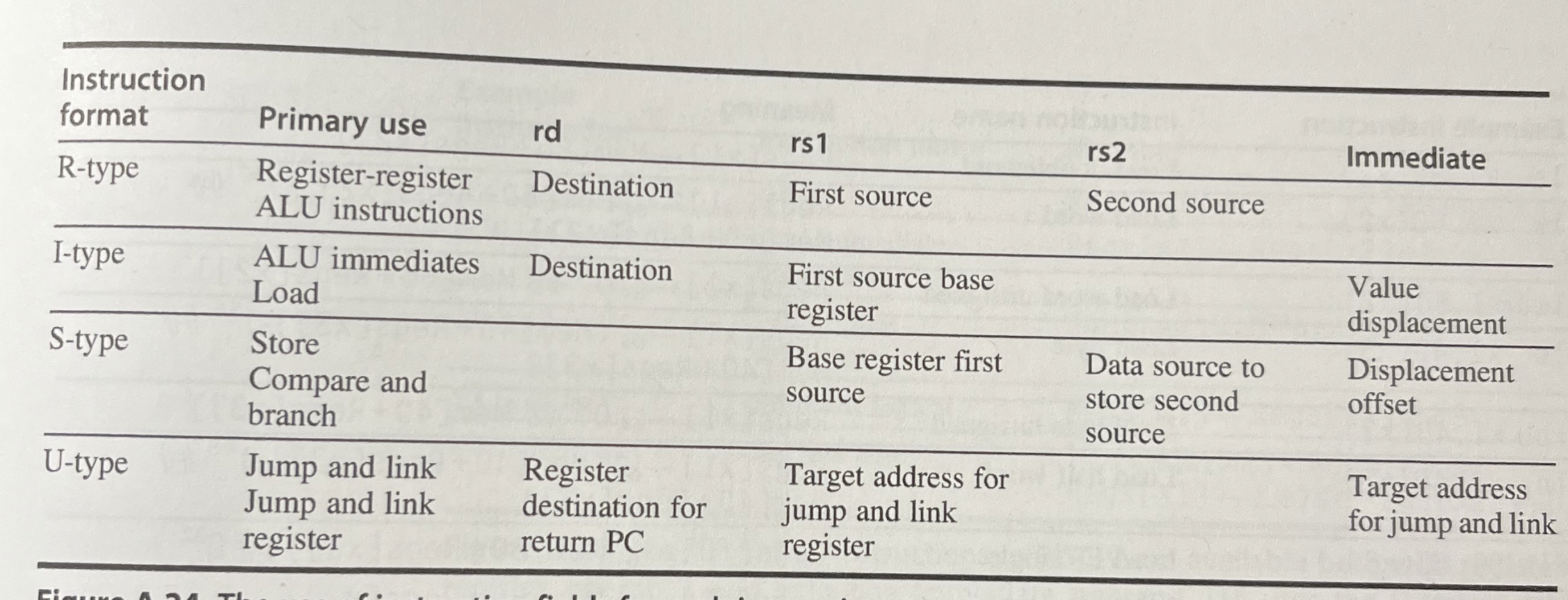
- Opcode specifies operations (ALU instruction, ALU immediate, load, store, branch, jump)
- “funct” fields $\rightarrow$ specific operations (add, subtract …)
RISC-V Operations (RV64G)
- Loads and stores

- ALU operations
- add, subtract, AND, OR, XOR, shifts, LUI (load upper immediate)
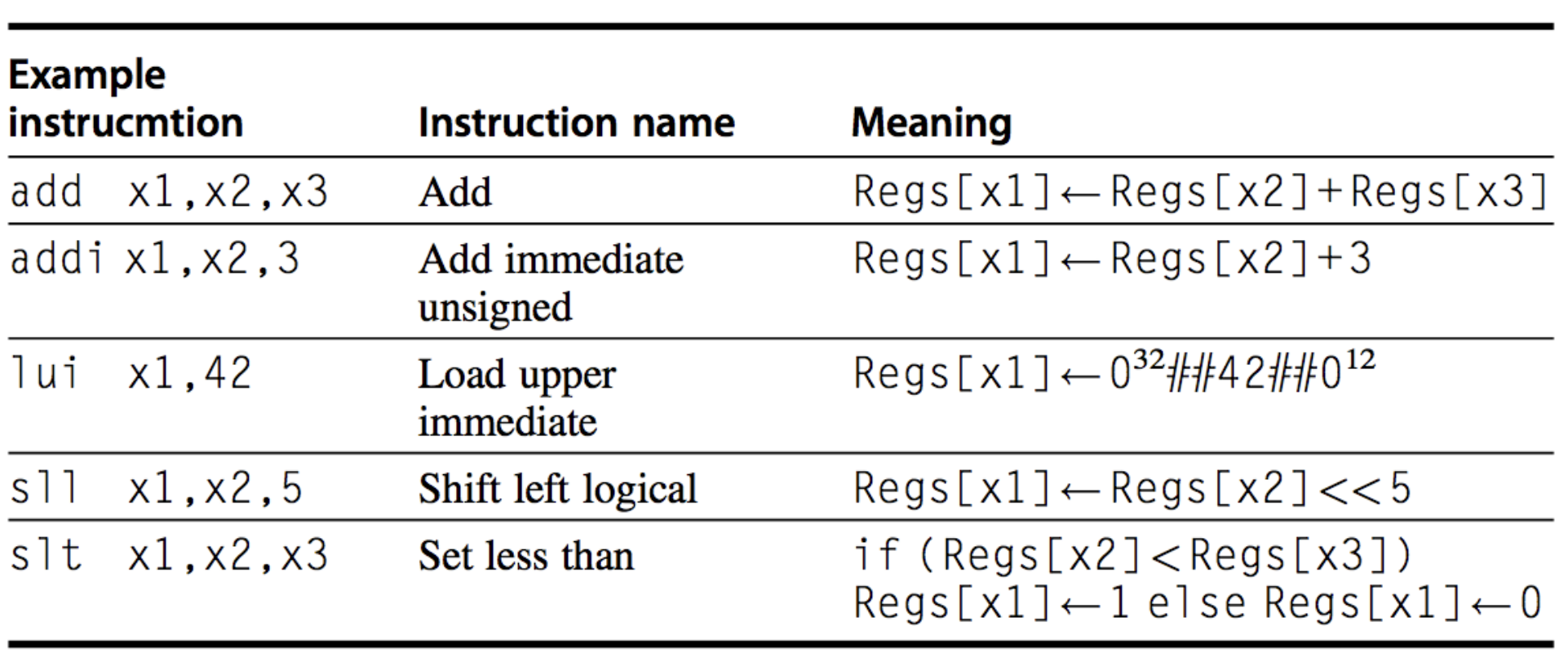
- add, subtract, AND, OR, XOR, shifts, LUI (load upper immediate)
- Branches and Jumps
- Floating-point
- RISC-V Control Flow Instructions
- Typical control flow instructions in RISC-V

- Offset: half word offset (so, need 1bit shift)
- Branches: equal, greater than, less than, their inverses)
- RISC-V Floating-Point Operations
- fadd.d/s: FP with double/single precision
- flw, fsw: FP load, FP store
RISC-V Instruction Set Cheatsheat by Erik Engheim
- Arithmetic operations
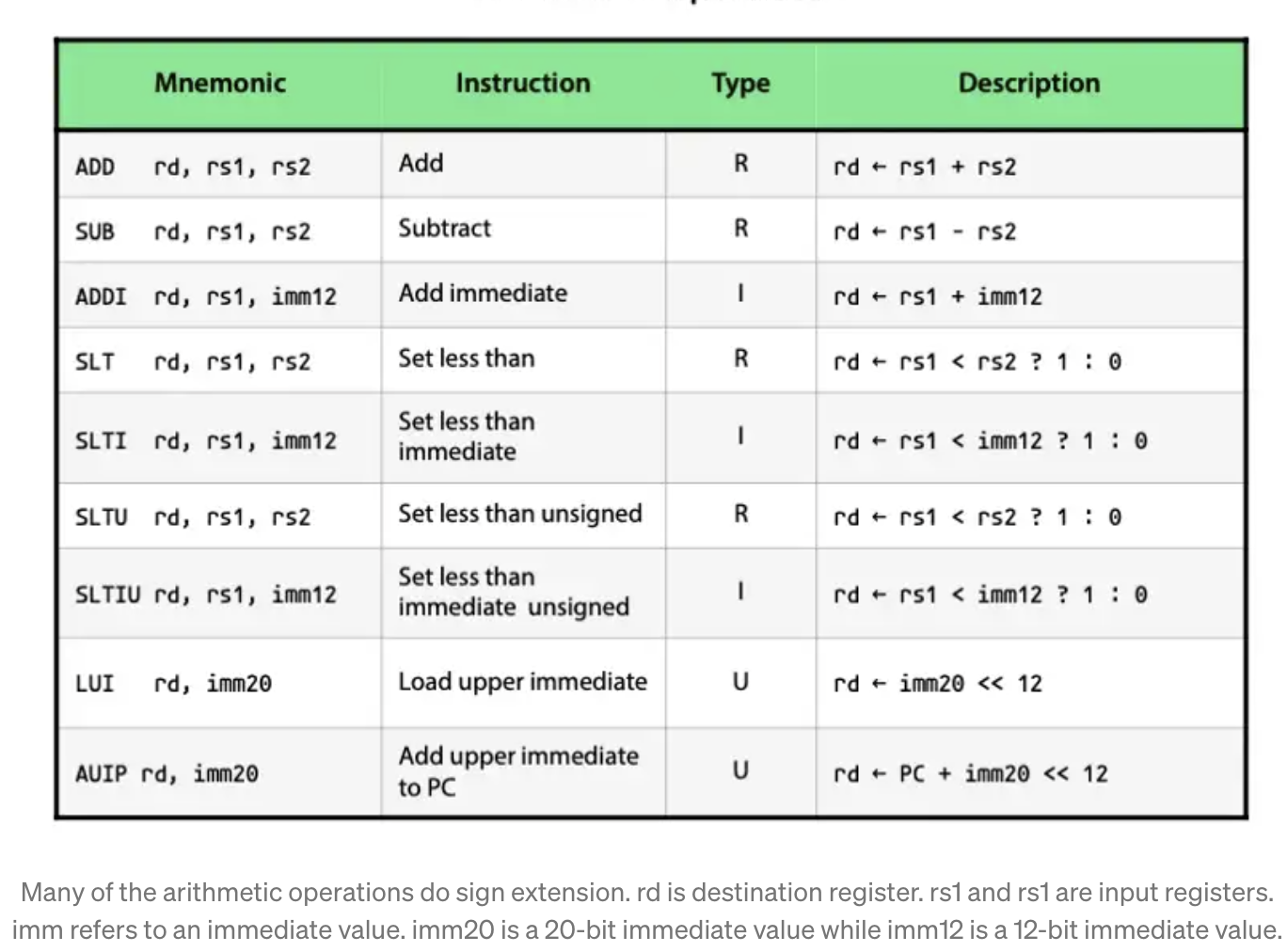
- Logical operations
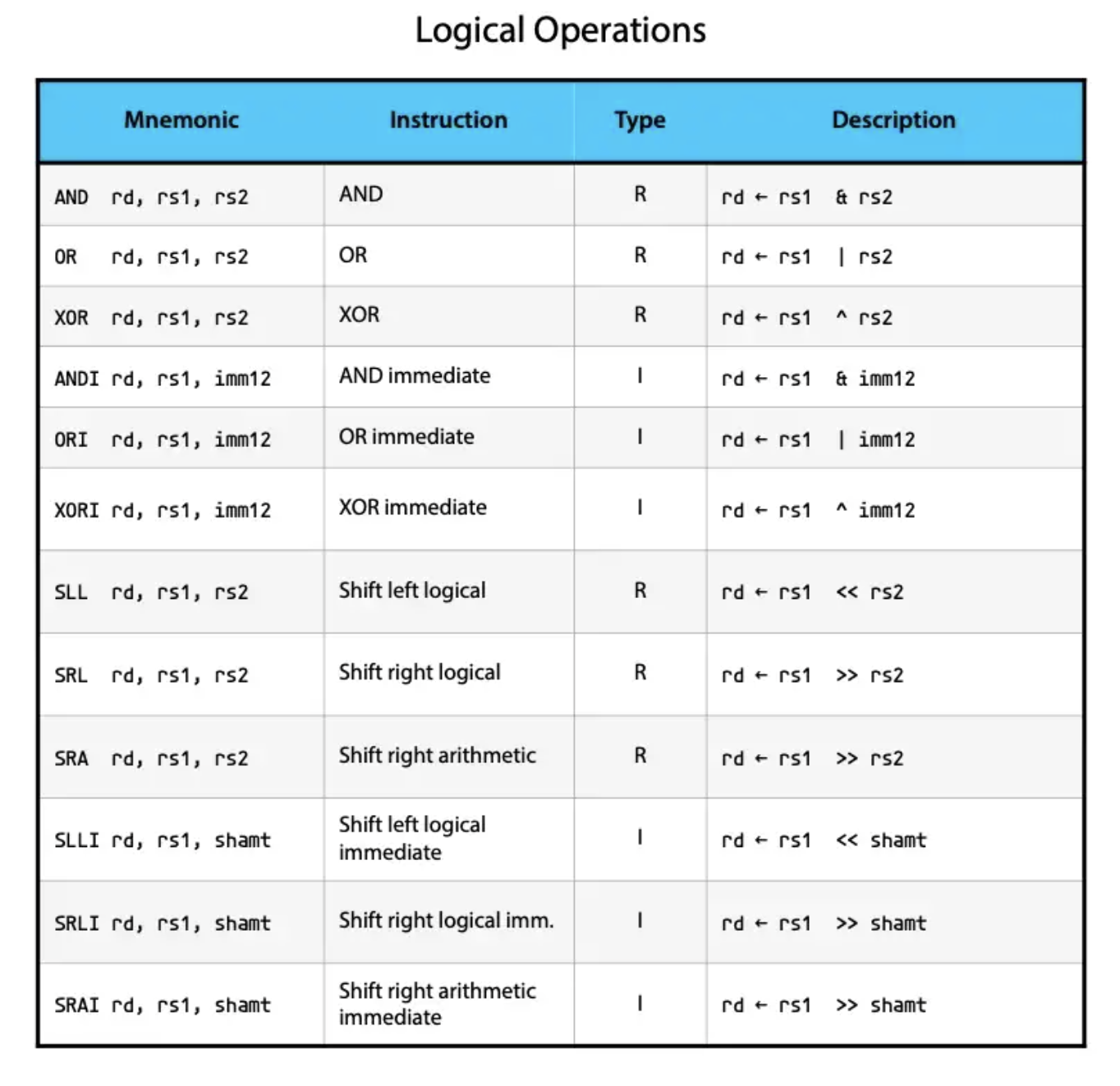
- Load/Store operations
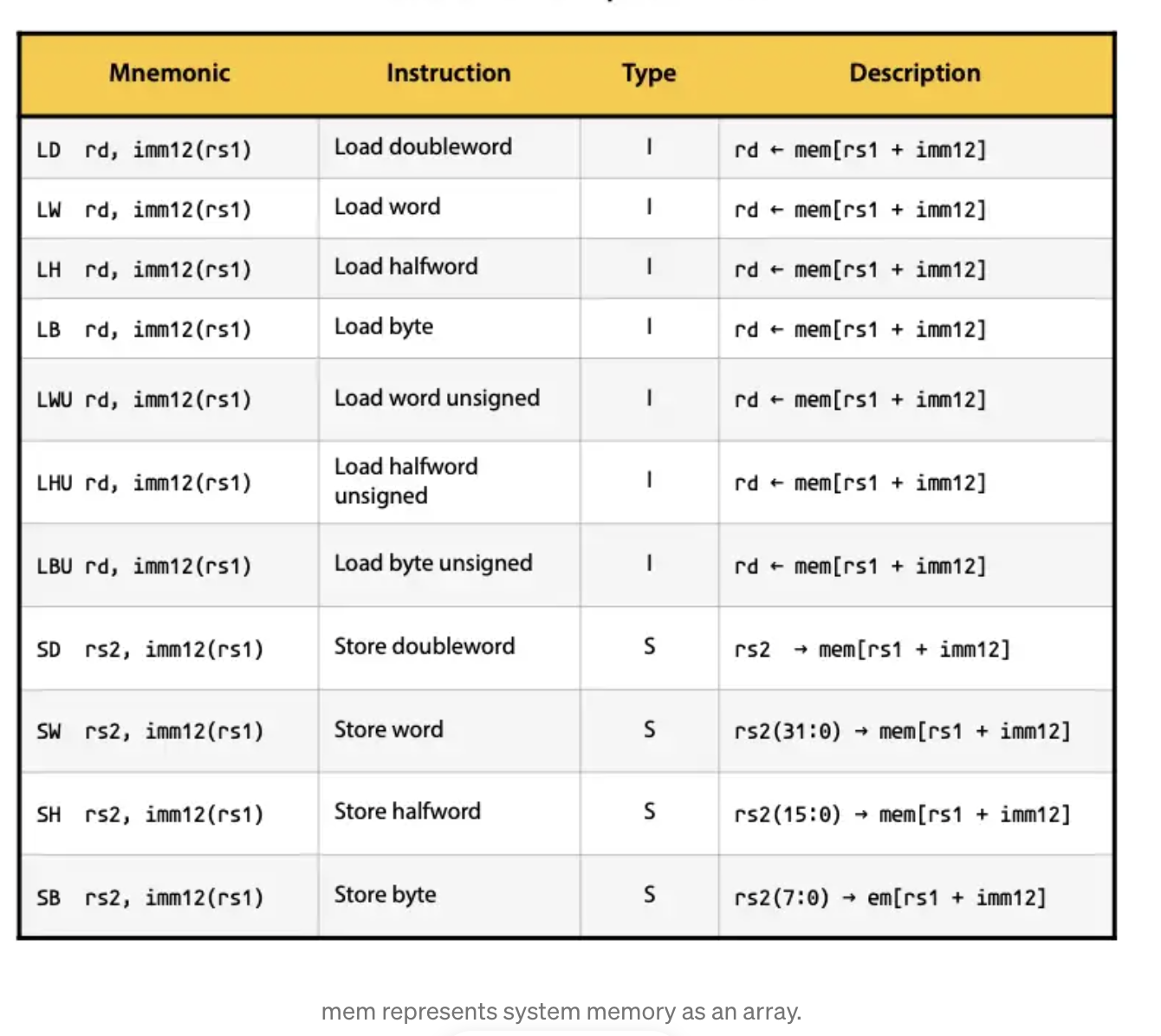
- Branching operations
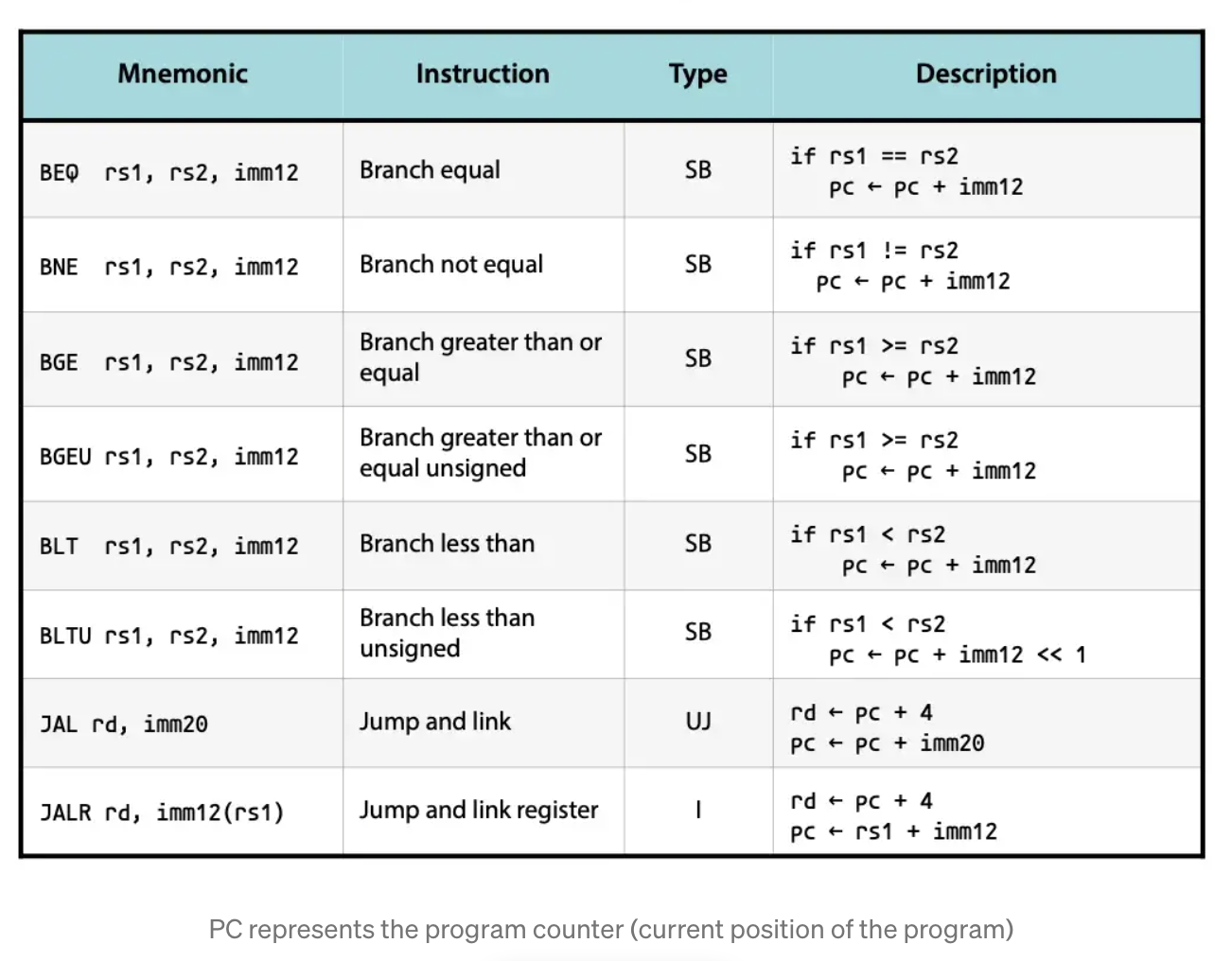
Reference
- Computer Architecture A Quantitative Approach (6th) by Hennessy and Patterson (2017)
- RISC-V Instruction-Set Cheatsheet by Erik Engheim
- USC RISC-V Lecture Note by Yonghong Yan
- Notebook: Computer Architecture Quantitive Approach
Notes Mentioning This Note
Table of Contents
- Instruction Set Principles
- Introduction
- Classifying Instruction Set Architectures
- Memory Addressing
- Type and Size of Operands
- Operations in the instruction set
- Instructions for Control Flow
- Encoding an Instruction Set
- Crosscutting Issues: The Role of Compilers
- Putting It All Together: The RISC-V Architecture
- Reference
